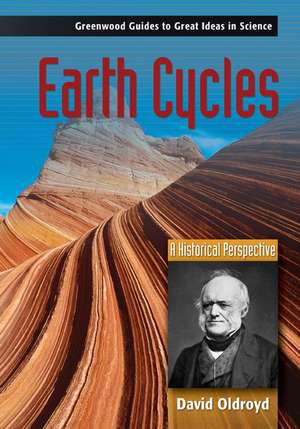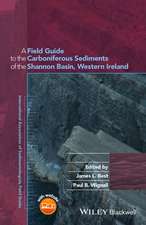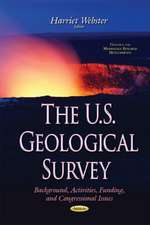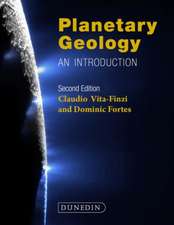Earth Cycles: A Historical Perspective
Autor David Oldroyden Limba Engleză Hardback – 29 iun 2006 – vârsta până la 17 ani
Preț: 307.29 lei
Preț vechi: 530.00 lei
-42% Nou
Puncte Express: 461
Preț estimativ în valută:
58.81€ • 61.17$ • 48.55£
58.81€ • 61.17$ • 48.55£
Carte tipărită la comandă
Livrare economică 15-29 aprilie
Preluare comenzi: 021 569.72.76
Specificații
ISBN-13: 9780313332296
ISBN-10: 0313332290
Pagini: 256
Dimensiuni: 178 x 254 x 22 mm
Greutate: 0.72 kg
Editura: Bloomsbury Publishing
Colecția Greenwood
Locul publicării:New York, United States
ISBN-10: 0313332290
Pagini: 256
Dimensiuni: 178 x 254 x 22 mm
Greutate: 0.72 kg
Editura: Bloomsbury Publishing
Colecția Greenwood
Locul publicării:New York, United States
Notă biografică
David Oldroyd is Honorary Visiting Professor in the School of History and Philosophy of Science at the University of New South Wales and was Secretary-General of the International Commission on the History of Geological Sciences for eight years. A recipient of awards for his historical work from the Geological Society of London, the Geological Society of America, and the Australian Commonwealth, he is the author of numerous articles and several books, including (in the geosciences): The Highlands Controversy: Constructing Geological Knowledge through Fieldwork in Nineteenth-century Britain, Sciences of the Earth: Studies in the History of Mineralogy and Geology, Thinking about the Earth: A History of Ideas in Geology, Earth, Water, Ice and Fire: Two Hundred Years of Geological Research in the English Lake District, and (with Jan Kozak and Victor Moreira) The Iconography of the Lisbon Earthquake.
Cuprins
Figure 2.1. Leonardo's "theory of the Earth" from his "Codex Leicester." (Leonardo d Vinci, 2000, 31)Figure 3.1a. Four stages in the Earth's development (Descartes 1656, 151).Figure 3.1b. Further development of the Earth (Descartes 1656, 155).Figure 3.2. Steno's scheme for the geological history of Tuscany (1669, unnumbered page, preceding ).Figure 3.3. Frontispiece to Burnet's Theory of the Earth (1684).Figure 3.4. Figure from Burnet's Theory of the Earth (1684, 57).Figure 3.5. Formation of oceans and mountains due to collapse structures (Burnet 1697, 227).Figure 4.1. The Earth, its envelope of water, and the initial directions of motion of freely falling objects at different latitudes, based on Hooke's account in his Posthumous Works.Figure 5.1. The "geostrophic cycle."Figure 5.2. Cross section of northern part of Arran, drawn by John Clerk, Jr., 1787.Figure 5.3. Geological sketch map of northern Arran showing likely line of section for Clerk's drawing (Figure 5.2).Figure 5.4. Unconformity at Loch Ranza, Arran, as figured by Archibald Geikie (1899).Figure 5.5. Profile of unconformity observed by Hutton near Jedburgh in 1787.Figure 5.6. Unconformity at Siccar Point.Figure 5.7. The evolving continuum of mineral substances from the residues of living organisms, according to Lamarck's Hydrogeology.Figure 6.1. The "Temple" of Serapis at Pozzuoli near Naples.Figure 6.2. Illustration of Lyell's theory of "random" creation and extinction of species.Figure 7.1. Development of canyon profiles according to the hardness of strata (Dutton 1882, plate 40, facing p. 250).Figure 7.2. Evolution of a landscape according to Davis, from Holmes (1944, 187).Figure 8.1. Part of the Earth's pentagonal arrangement of mountain ranges (Élie de Beaumont 1852, vol. 3, plate 5).Figure 8.2. Cooling, contracting globe (Dana 1847a, 181).Figure 8.3. Depiction of Dana's ideas on mountain building, as reconstructed by Dott (1997, 299).Figure 8.4. Folds and dislocations due to (a) lateral compression (b) subsidence, according to Suess.Figure 8.5. Suess's model of mountain building (S¸engör 1982, 400, fig. 4).Figure 8.6. Breakup of Pangea, according to Wegener's Origin of Continents and Oceans (1966, 18-19).Figure 8.7. Convection currents within the Earth's mantle, producing continental drift (Holmes 1929, 579).Figure 8.8. Development of geosynclines and the formation of mountains (Holmes 1929, 582).Figure 8.9. Convection currents within the Earth (Holmes 1944, 506).Figure 8.10. Magnetization of the rocks of the ocean floor off the coast of western Canada (Mason and Raff 1961, 1268).Figure 8.11. The "ideal" Bouma sequence, as depicted by Bouma (1962, 49).Figure 8.12. Hypothetical form of the deposition cone of a turbidity current and hypothetical filling of a basin by turbidites.Figure 9.1. Global changes in temperature over time (Agassiz 1837).Figure 9.2. Earth's orbit around the Sun, illustrating the phenomenon of precession.Figure 9.3. Changes of the Earth's alignment in space, at periods of high orbital ellipticity, as depicted by Croll (1875, frontispiece).Figure 9.4. Milankovic's radiation graphs for 55°, 60°, and 65°N, as published in Köppen and Wegener (1924, plate facing p. 256).Figure 9.5. Components of the variations of the Earth's motion in space, through time (Berger 1988, 636).Figure 10.1. Sediment record in a sinking basin undergoing oscillations in base level (Barrell 1917, 796).Figure 10.2. Sedimentation cycles (Udden 1912, 27).Figure 10.3. Correlations of strata in western Illinois (Wanless 1931, 189).Figure 10.4. Ideal cyclothem (Willman and Payne 1942, 86).Figure 10.5a. Cyclothems (Holliday Drive, Kansas City, by the southern bank of the Kansas River, near its junction with the Missouri River).Figure 10.5b. Limestone with shale partings (Holliday Drive, Kansas City).Figure 10.6. De Geer examining varves in Vermont, 1920.Figure 11.1. Generalized section from the Pacific to the Rockies (northwestern United States) (Wheeler 1958, 1052).Figure 11.2. Time-stratigraphic diagram, representing the sequences depicted in Figure 11.1 (Wheeler 1958, 1053).Figure 11.3. Time-stratigraphic relationships for sequences of the North American craton (Sloss 1963, 110).Figure 11.4. The Vail curve, as unveiled in 1977, with two levels of resolution (Vail et al. 1977a, 84).Figure 11.5. Conversion of data obtained from seismic stratigraphy into part of a Vail curve (Vail et al. 1977a, 78).Figure 11.6. The "averaging" of sea-level curves from four different regions to yield a global sea-level curve, right-hand drawing (Vail et al. 1977b, 90).Figure 11.7. Profile of a typical sequence and a corresponding Wheeler diagram (Haq et al. 1987, 1157).Figure 12.1. Part of the geomagnetic time scale (Hoffman 1988, 55).Figure 12.2. Variations of oxygen isotope composition with depth for two species of foraminifera for a Caribbean core (V12-122) (Broecker and Van Donk 1970, 175).Figure 12.3. Comparison of oxygen isotope ratios and magnetic polarities for Lamont Core V28-238 (Shackleton and Opdyke 1973, 48, fig. 9).Figure 13.1. Nieuwenkamp's "persedimentary" model of the continuous rock series (Nieuwenkamp 1968, 366, fig. 1).Figure 13.2. The "crust-ocean factory" (Garrels and Mackenzie 1971, 330).Figure 13.3. The "steady-state flow net" (Garrels and Perry 1974, 313).Figure 13.4. Comparison of d13C carbonate and d34S sulfate isotope curves for Phanerozoic time (Holser et al. 1988, 139, 140).Figure 13.5. Comparison through the Phanerozoic of d13Ooxidized and d13Oreduced, reduced carbon/total carbon, and sea levels (Pigott 1981, fig. 15).
Recenzii
The book examines the historical and theoretical contexts for the development of cyclic theories in the geosciences (chapters 1-6); the practical utilization of cyclic theories in the geosciences, namely, geophysics, geochemistry, structural geology, soil science, oceanography/hydrology, glaciology, and the atmospheric sciences (chapters 7-13); and the summarization and meta-theoretical discussion of the centrality of cyclicity in the geosciences (chapter 14)..[p]rovides an apt introduction and overview of cyclic theories and cyclicity in geoscience. List of illustrations; time line; international stratigraphic chart; glossary; further reading list. Recommended. General readers; lower-division undergraduates through professionals.
For high school and college students and the general reader, Oldroyd outlines the history of cyclic theories in geoscience, beginning with the ancient world and the Renaissance. He then details the ideas of Robert Hooke, James Hutton, and Charles Lyell, and the historical development of concepts involving the Earth's landscape, the solar system, glaciation, cycles in the strata, sequence stratigraphy and eustasy, the geomagnetic time scale, and geochemical cycling.
For high school and college students and the general reader, Oldroyd outlines the history of cyclic theories in geoscience, beginning with the ancient world and the Renaissance. He then details the ideas of Robert Hooke, James Hutton, and Charles Lyell, and the historical development of concepts involving the Earth's landscape, the solar system, glaciation, cycles in the strata, sequence stratigraphy and eustasy, the geomagnetic time scale, and geochemical cycling.









